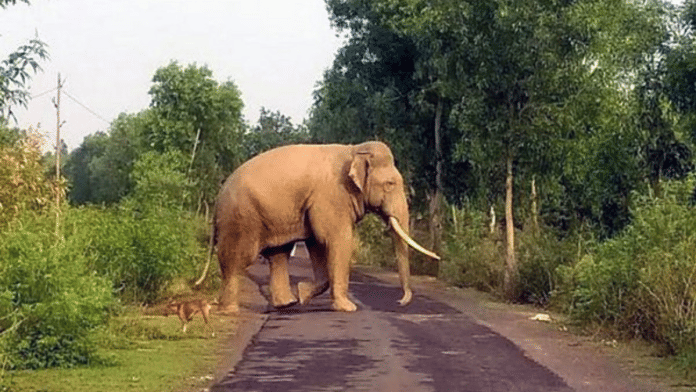Bhopal: The Madhya Pradesh forest department is rolling out a string of tech-driven measures—from a radio bulletin on elephant movement to a WhatsApp group to alert villagers—in an effort to promote peaceful co-existence between the state’s human population and increasing elephant population.
One of the prominent efforts is a special morning broadcast on All India Radio called ‘Haathi Samachar’ (elephant news), which updates local residents on elephant movements in the state. Along with the radio broadcast, the forest department has also created WhatsApp groups at the district level—called ‘Haathi Mitra Dals’—to alert and prepare the villagers.
Apart from these measures, awareness programmes are also being held in various districts informing villagers about the history of elephant movement and the ‘dos and don’ts’ when encountering elephants.
The forest department will also set up an elephant control centre to map the movement of elephants and adopt the Gaj Sanket app, launched by the neighbouring Chhattisgarh government, to allow seamless coordination of elephant movement across state borders.
These measures come nearly two months after 10 elephants died in Bandhavgarh district after eating fungus-infected kodo millet, bringing the human-elephant conflict issue to the forefront of wildlife management in the state.
The Madhya Pradesh government sent officers to Karnataka, Tamil Nadu, Chhattisgarh and other states to study their strategies for preventing human and animal casualties while promoting coexistence.
“Most of the casualties of man-elephant conflict are when people either come in the way of elephants or when humans try to protect their crops from elephants as they raid homes that have crops or mahua (local liquor) stored in them,” Principal Chief Conservator of Forest (Wildlife) Subharanjan Sen told The Print.
“We are working to implement measures to reduce this to as minimum as possible.”
Also Read: Bandhavgarh elephants might have eaten fungus-infected millets. How ‘kodo poisoning’ can prove fatal
Tracking elephants
Elephants have been entering Madhya Pradesh from Chhattisgarh’s Pendra-Marwahi-Gaurela district and Achanakmar Wildlife Sanctuary since 2003.
However, in 2017, a herd of 40 elephants came and settled in Bandhavgarh Tiger Reserve, which spreads across the Umaria and Shahdol districts of Madhya Pradesh. Over the years, the herd has grown to 60.
In the past five years, the number of elephants coming into Madhya Pradesh has not only increased, but they have been staying in the state for up to 8 months before returning to Chhattisgarh.
Districts along the Chhattisgarh border—including Sidhi, Singrauli, Dindori, Anuppur, Shahdol, Mandla and Balaghat—are most affected.
Today, close to 100 elephants roam across Bandhavgarh Tiger Reserve, the Sanjay-Dubri Tiger Reserve, North Shahdol and Anuppur district.
In an effort to prevent human-elephant conflict, the forest department has radio-collared two wild elephants in Bandhavgarh and will be collaring a few more to track their movement patterns.
Forest officers say monitoring an elephant’s movements around a specific village helps predict how far the elephant will travel in a day.
Authorities can use this data to alert villagers within a 5-km radius and advise them to stay away from the jungles during that time.
“Having monitored these two elephants, we have realised that their movement is mostly between 6 am to 8 am in the morning and 4 pm and 6 pm in the evening. Such specific information can go a long way in reducing conflict,” a senior state government official said.
When elephant movement is recorded around certain villages, the forest department will issue bulletins to alert villagers so they can avoid entering affected areas.
As part of a pilot project, this initiative has been launched in Shahdol district and will soon be expanded to seven districts in eastern Madhya Pradesh.
Another senior official said a herd of three elephants moved from Shahdol to Satna in November, the first time that Satna villagers faced elephant movement. The incident triggered panic, with villagers trying to drive the elephants in different directions, creating chaos.
Of the three, one tusker was electrocuted after coming in contact with an 11,000-kilowatt power line dangling about three metres above the ground.
“As elephants are entering newer areas, such problems are also coming to the fore and they will require coordinated efforts from various departments,” added the official.
The state government is also in the process of setting up the first elephant control room in Bandhavgarh and another one at Van Bhawan, the forest department’s headquarters in Bhopal.
The control room in Bandhavgarh will collate data from all seven elephant-affected districts in east Madhya Pradesh and send this information daily to the state headquarters in Bhopal.
In addition to gathering data, these control rooms will play a key role in mobilising resources in a coordinated manner, if necessary.
The forest department has also requested revenue officers, including district collectors of the elephant-affected districts, to prioritise the allocation of pucca homes to tribals living in buffer zones or forest areas, which will ensure mud homes are not easily demolished by elephants when they come to raid crops.
“There are states such as Karnataka where there is a high density of elephants in specific regions such as Coorg, but the casualties of both animals or humans are few and far between,” Additional Principal Chief Conservator of Forest (Wildlife) L. Krishnamurthy told The Print.
“This only happens as people there are used to these elephants and aware of their behaviour and act accordingly. Madhya Pradesh now also needs to learn to live with elephants and we are working in that direction.”
(Edited by Sugita Katyal)






